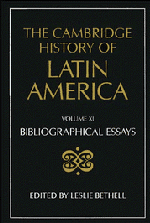Book contents
- Frontmatter
- I THE INDIGENOUS PEOPLES OF MIDDLE AND SOUTH AMERICA ON THE EVE OF THE CONQUEST
- II COLONIAL SPANISH AMERICA
- III COLONIAL BRAZIL
- IV THE INDEPENDENCE OF LATIN AMERICA
- V LATIN AMERICA: ECONOMY, SOCIETY, POLITICS, c. 1820 TO c. 1870
- VI LATIN AMERICA: ECONOMY, SOCIETY, POLITICS, c. 1870 to 1930
- 1 Latin America and the international economy, 1870–1914
- 2 Latin America and the international economy, 1914–1929
- 3 Population
- 4 Rural Spanish America
- 5 The growth of cities
- 6 Industry
- 7 The urban working class and early labour movements
- 8 The Catholic church
- 9 Mexico: Restored republic and Porfiriato, 1867–1910
- 10 The Mexican Revolution, 1910–1920
- 11 Mexico: Revolution and reconstruction in the 1920s
- 12 Central America
- 13 Cuba
- 14 Puerto Rico
- 15 The Dominican Republic
- 16 Haiti
- 17 Argentina: Economy, 1870–1914
- 18 Argentina: Society and politics, 1880–1916
- 19 Argentina, 1914–1930
- 20 Uruguay
- 21 Paraguay
- 22 Chile
- 23 Bolivia
- 24 Peru
- 25 Colombia
- 26 Ecuador
- 27 Venezuela
- 28 Brazil: Economy
- 29 Brazil: Society and politics, 1870–1889
- 30 Brazil: Society and politics, 1889–1930
- VII LATIN AMERICA: ECONOMY, SOCIETY, POLITICS, 1930 to c. 1990
- VIII IDEAS IN LATIN AMERICA SINCE INDEPENDENCE
- IX LATIN AMERICAN CULTURE SINCE INDEPENDENCE
- X THE INTERNATIONAL RELATIONS OF LATIN AMERICA SINCE INDEPENDENCE
- THE CAMBRIDGE HISTORY OF LATIN AMERICA
3 - Population
from VI - LATIN AMERICA: ECONOMY, SOCIETY, POLITICS, c. 1870 to 1930
Published online by Cambridge University Press: 28 March 2008
- Frontmatter
- I THE INDIGENOUS PEOPLES OF MIDDLE AND SOUTH AMERICA ON THE EVE OF THE CONQUEST
- II COLONIAL SPANISH AMERICA
- III COLONIAL BRAZIL
- IV THE INDEPENDENCE OF LATIN AMERICA
- V LATIN AMERICA: ECONOMY, SOCIETY, POLITICS, c. 1820 TO c. 1870
- VI LATIN AMERICA: ECONOMY, SOCIETY, POLITICS, c. 1870 to 1930
- 1 Latin America and the international economy, 1870–1914
- 2 Latin America and the international economy, 1914–1929
- 3 Population
- 4 Rural Spanish America
- 5 The growth of cities
- 6 Industry
- 7 The urban working class and early labour movements
- 8 The Catholic church
- 9 Mexico: Restored republic and Porfiriato, 1867–1910
- 10 The Mexican Revolution, 1910–1920
- 11 Mexico: Revolution and reconstruction in the 1920s
- 12 Central America
- 13 Cuba
- 14 Puerto Rico
- 15 The Dominican Republic
- 16 Haiti
- 17 Argentina: Economy, 1870–1914
- 18 Argentina: Society and politics, 1880–1916
- 19 Argentina, 1914–1930
- 20 Uruguay
- 21 Paraguay
- 22 Chile
- 23 Bolivia
- 24 Peru
- 25 Colombia
- 26 Ecuador
- 27 Venezuela
- 28 Brazil: Economy
- 29 Brazil: Society and politics, 1870–1889
- 30 Brazil: Society and politics, 1889–1930
- VII LATIN AMERICA: ECONOMY, SOCIETY, POLITICS, 1930 to c. 1990
- VIII IDEAS IN LATIN AMERICA SINCE INDEPENDENCE
- IX LATIN AMERICAN CULTURE SINCE INDEPENDENCE
- X THE INTERNATIONAL RELATIONS OF LATIN AMERICA SINCE INDEPENDENCE
- THE CAMBRIDGE HISTORY OF LATIN AMERICA
Summary
In the absence of a general analysis, except for the relevant chapters of Nicolás Sánchez-Albornoz, The Population of Latin America: A History (Berkeley, 1974); 2nd Spanish ed., Lapoblación de América Latina: Desde los tiempos precolombinos al ano 2000 (Madrid, 1977), the reader should follow the development of the population of Latin America in the period from 1870 to 1930 in books and articles on the individual countries. For Argentina, CELADE (Centro Latinoamericano de Demografía), Temas de población de la Argentina: Aspectos demográficos (Santiago, Chile, 1973) and Zulma Recchini de Lattes and Alfredo E. Lattes (eds.), La población de Argentina (Buenos Aires, 1975) have compiled parallel studies which provide an overall view of the principal demographic variables since 1889. La población de Cuba (Havana, 1976) was conceived in the same way, but is not backed up by such detailed previous research. For Brazil, T. W. Merrick and D. H. Graham, Population and Economic Development in Brazil: 1800 to the Present (Baltimore, 1979) attempts to achieve a balance between chronological presentation and a diachronic discussion of themes. The Centro de Estudios de Población y Desarrollo in Lima has, for its part, made a notable attempt at historical reconstruction in its Informe demográfico del Perú: 1970 (Lima, 1972). However, there was not one single census report in Peru between 1876 and 1940, which means that the study can only be of limited use. On Mexico the two volumes by Moisés González Navarro, Población y sociedad en México (1900–1970) (Mexico, D.F., 1974), although amply documented, lack the analytical technique used by demographers in the other books already mentioned. On Uruguay, see J. Rial, Población y desarrollo de un pequeno país: Uruguay 1850–1930 (Montevideo, 1983).
- Type
- Chapter
- Information
- The Cambridge History of Latin America , pp. 331 - 336Publisher: Cambridge University PressPrint publication year: 1995



